Stocks surged on Tuesday with the major index ETFs gaining over 2%. The gains were rather uniform with a range from 2.27% in the S&P 100 to 2.82% in the Nasdaq 100. Even though the Nasdaq and Russell 2000 gained more than the S&P 500, I would have expected more outperformance from these two high-beta indices. All sectors were up with industrials, energy and technology leading the way. Of note, the S&P 500 ETF (SPY) and Dow SPDR (DIA) broke resistance, but the Russell 2000 ETF (IWM) and Nasdaq 100 ETF (QQQQ) finished right at resistance. No confirmation breakout just yet for these two.
Breadth was strong, but volume was light. NYSE breadth remains stronger than Nasdaq breadth. The first chart shows the NYSE AD Volume Line breaking above its late May high with a surge over the last seven days. In contrast, the Nasdaq AD Volume Line has yet to break resistance. The AD Volume Lines reflect the balance between buying and selling pressure. Buying pressure wins the day when Net Advancing Volume is positive. Selling pressure wins when Net Advancing Volume is negative. Net Advancing Volume equals the volume of advancing stocks less the volume of declining stocks. Because large-caps dominate the most active list, this indicator reflects large-cap performance. Total volume on the NYSE and Nasdaq was below average, but we have see low volume advances prevail in the past. The February-April 2010 advance and the July-August 2009 advance both occurred with uninspiring volume. The AD Volume Line and Net Advancing Volume ignore overall volume by focusing on the battle between buying pressure and selling pressure.

Breadth was strong, but volume was light. NYSE breadth remains stronger than Nasdaq breadth. The first chart shows the NYSE AD Volume Line breaking above its late May high with a surge over the last seven days. In contrast, the Nasdaq AD Volume Line has yet to break resistance. The AD Volume Lines reflect the balance between buying and selling pressure. Buying pressure wins the day when Net Advancing Volume is positive. Selling pressure wins when Net Advancing Volume is negative. Net Advancing Volume equals the volume of advancing stocks less the volume of declining stocks. Because large-caps dominate the most active list, this indicator reflects large-cap performance. Total volume on the NYSE and Nasdaq was below average, but we have see low volume advances prevail in the past. The February-April 2010 advance and the July-August 2009 advance both occurred with uninspiring volume. The AD Volume Line and Net Advancing Volume ignore overall volume by focusing on the battle between buying pressure and selling pressure.

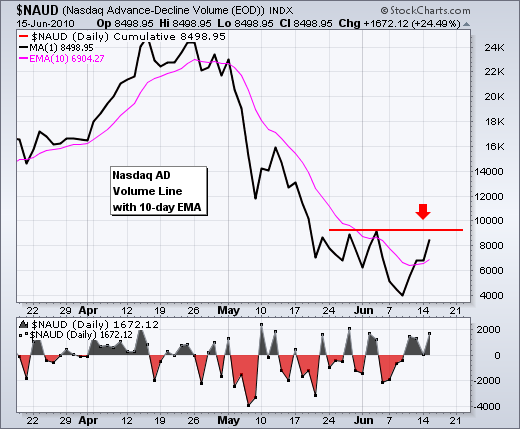
On the daily chart, SPY broke resistance with a long white candlestick and strong close. The ETF is now up over 6% in seven trading days and getting short-term overbought. The Fibonacci Retracements Tool is shown to mark potential targets for this advance. The 50% retracement comes into play around 113.4 and the 62% retracement is around 115.5. As noted before, there is often a pullback or consolidation after such breakouts. This could be as a falling flag or even a sideways trading range. RSI confirmed the breakout with a move above 50 for the first time since early May.
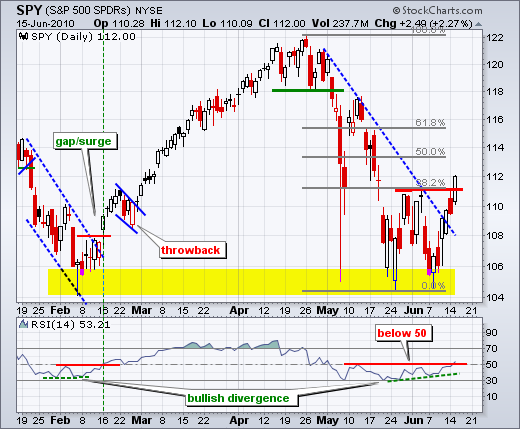
On the 30-minute chart, SPY found support near the pennant high and surged to 112 with a strong move. The short-term trend is clearly up with a 3.77% advance in four days. The pennant high and Monday's low mark support around 109.5 for now. RSI broke above 60 on Monday morning, fell back by the close and moved above 60 on Tuesday. Short-term momentum favors the bulls and I can now set the 40-50 zone as support. A pullback into this zone could provide an opportunity to enter the uptrend with lower risk.
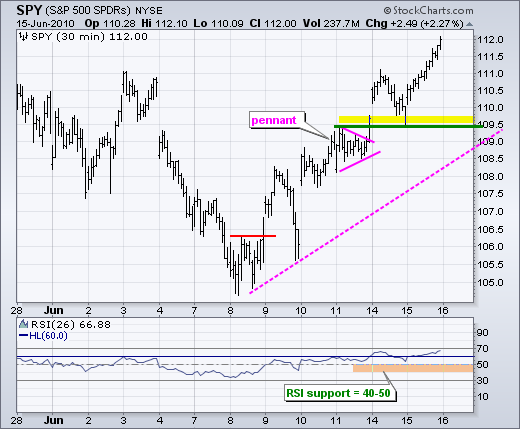
Key Economic Reports:
Wed - Jun 16 - 08:30 - Housing Starts
Wed - Jun 16 - 08:30 - Building Permits
Wed - Jun 16 - 08:30 - PPI
Wed - Jun 16 - 09:15 - Industrial Production
Wed - Jun 16 - 10:30 - Crude Inventories
Thu - Jun 17 - 08:30 - Initial Claims
Thu - Jun 17 - 08:30 - CPI
Thu - Jun 17 - 10:00 - Leading Indicators
Thu - Jun 17 - 10:00 - Philadelphia Fed
Charts of Interest: CIEN, CSCO, DELL, POOL
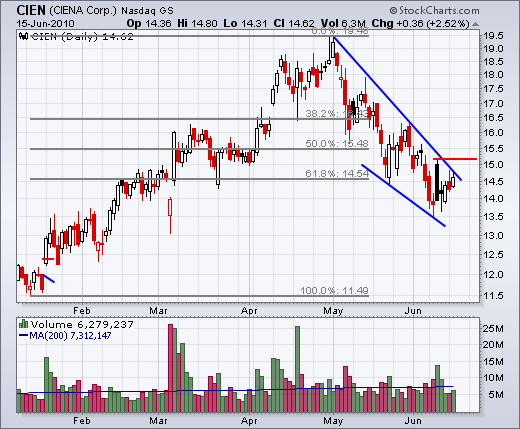
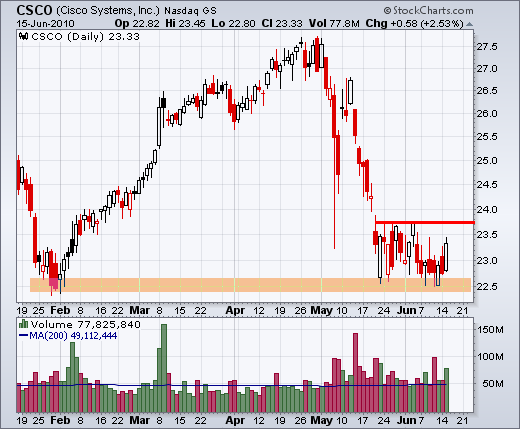
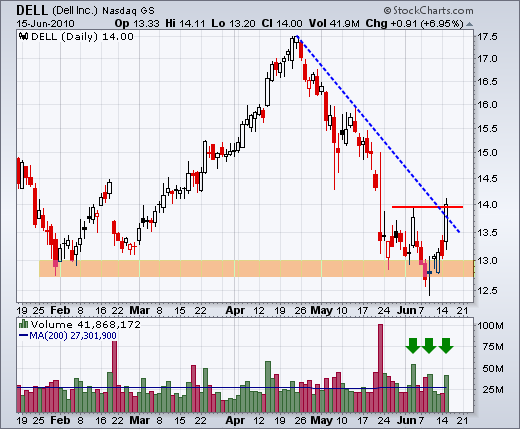

This commentary and charts-of-interest are designed to stimulate thinking. This analysis is not a recommendation to buy, sell, hold or sell short any security (stock ETF or otherwise). We all need to think for ourselves when it comes to trading our own accounts. First, it is the only way to really learn. Second, we are the only ones responsible for our decisions. Think of these charts as food for further analysis. Before making a trade, it is important to have a plan. Plan the trade and trade the plan. Among other things, this includes setting a trigger level, a target area and a stop-loss level. It is also important to plan for three possible price movements: advance, decline or sideways. Have a plan for all three scenarios BEFORE making the trade. Consider possible holding times. And finally, look at overall market conditions and sector/industry performance.

About the author:
Arthur Hill, CMT, is the Chief Technical Strategist at TrendInvestorPro.com. Focusing predominantly on US equities and ETFs, his systematic approach of identifying trend, finding signals within the trend, and setting key price levels has made him an esteemed market technician. Arthur has written articles for numerous financial publications including Barrons and Stocks & Commodities Magazine. In addition to his Chartered Market Technician (CMT) designation, he holds an MBA from the Cass Business School at City University in London.
Learn More





